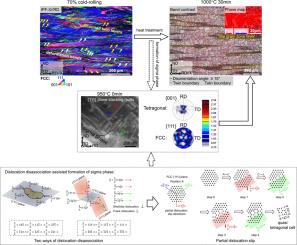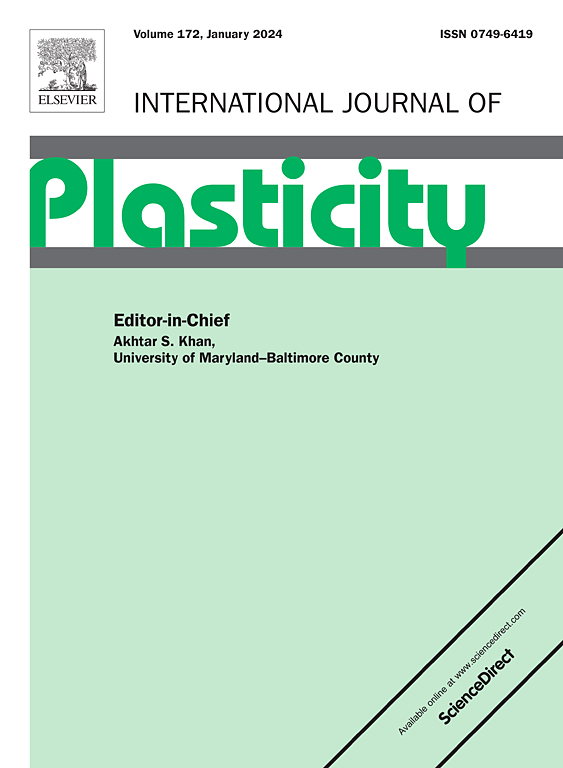Dislocation dissociation assisted formation mechanism of sigma phase and its impact on producing heterogeneous lamellar microstructure in CoCrV medium-entropy alloy
IF 9.4
1区 材料科学
Q1 ENGINEERING, MECHANICAL
引用次数: 0
Abstract
Control of topologically close-packed sigma phase, meaning limiting its massive presence to avoid embrittlement but benefiting its refinement and strengthening effect, is of particular interest. In-depth knowledge of dislocation-associated formation mechanisms is needed but not well addressed. In this work, an FCC-phased Co66.66Cr16.67V16.67 medium entropy alloy (MEA) with a propensity to form the sigma phase at non-equilibrium conditions was studied. The alloy was conventionally cold-rolled and heat-treated. The dislocation activity rooted formation mechanisms of the sigma phase were thoroughly characterized and evidenced by in-situ and ex-situ multi-scale diffraction techniques. It was revealed that nano-sized sigma particles enriched in Cr and V and depleted in Co were precipitated ultra-rapidly and uniquely during the heating process after the cold-rolling. The precipitation is spatially inhomogeneous, mainly in the severely deformed regions. The ultra-rapidity of the precipitation was achieved by the segregation of the Cr and V atoms via crystal defect-aided diffusion for composition change and by structure transformation via dislocation dissociation. The similarity of the atomic arrangement of the partial dislocations to that of the {001} sigma planes provides favorable structure transformation stimulus. In consequence, the orientations of the intensively activated dislocation slip planes dictated those of the sigma {001} planes via the FCC {111} to sigma {001} heredity, leading to the specific sigma texture. Owing to the spatially inhomogeneous precipitation, a heterogeneous lamellar microstructure was formed, composed of alternatively distributed fine dual-phased layers and coarse single-phased layers. This work provides comprehensive information on the dislocation-dissociation-assisted formation mechanism of sigma phase.


CoCrV中熵合金中位错解离辅助sigma相形成机理及其对非均匀片层组织产生的影响
控制拓扑紧密堆积的sigma相,意味着限制其大量存在以避免脆化,但有利于其细化和强化效果,是特别感兴趣的。深入了解错位相关的形成机制是必要的,但尚未得到很好的解决。本文研究了在非平衡条件下易形成sigma相的fcc相Co66.66Cr16.67V16.67中熵合金(MEA)。该合金通常是冷轧和热处理。利用原位和非原位多尺度衍射技术对sigma相的位错活性根形成机制进行了全面表征和证明。结果表明,在冷轧后的加热过程中,析出了富集Cr和V、贫Co的纳米sigma颗粒。降水在空间上不均匀,主要集中在变形严重的地区。通过晶体缺陷辅助扩散使Cr和V原子偏析,通过位错解离使结构转变,实现了超高速析出。部分位错的原子排列与{001}σ平面的相似提供了有利的结构转变刺激。因此,通过FCC{111}到sigma{001}的遗传,密集激活的位错滑移面的取向决定了sigma{001}面的取向,从而导致特定的sigma织构。由于析出在空间上的不均匀性,形成了由细的双相层和粗的单相层交替分布的非均匀层状组织。这项工作为位错-解离辅助sigma相形成机制提供了全面的信息。
本文章由计算机程序翻译,如有差异,请以英文原文为准。
求助全文
约1分钟内获得全文
求助全文
来源期刊

International Journal of Plasticity
工程技术-材料科学:综合
CiteScore
15.30
自引率
26.50%
发文量
256
审稿时长
46 days
期刊介绍:
International Journal of Plasticity aims to present original research encompassing all facets of plastic deformation, damage, and fracture behavior in both isotropic and anisotropic solids. This includes exploring the thermodynamics of plasticity and fracture, continuum theory, and macroscopic as well as microscopic phenomena.
Topics of interest span the plastic behavior of single crystals and polycrystalline metals, ceramics, rocks, soils, composites, nanocrystalline and microelectronics materials, shape memory alloys, ferroelectric ceramics, thin films, and polymers. Additionally, the journal covers plasticity aspects of failure and fracture mechanics. Contributions involving significant experimental, numerical, or theoretical advancements that enhance the understanding of the plastic behavior of solids are particularly valued. Papers addressing the modeling of finite nonlinear elastic deformation, bearing similarities to the modeling of plastic deformation, are also welcomed.
 求助内容:
求助内容: 应助结果提醒方式:
应助结果提醒方式:


